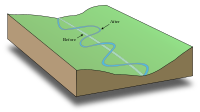
Photo from wikipedia
Abstract In this study, we focus on the environmental changes recorded in the San River valley (Stubno–Naklo site, south-eastern Poland) at the beginning of the Holocene. This multi-proxy study for… Click to show full abstract
Abstract In this study, we focus on the environmental changes recorded in the San River valley (Stubno–Naklo site, south-eastern Poland) at the beginning of the Holocene. This multi-proxy study for the first time in the region of the northern foreland of the Western Carpathians included quantitative thermal reconstruction based on Chironomidae and high-stratigraphic resolution of 14C AMS dating. We hypothesised that (i) climate events during the Early Holocene contributed to ecosystem turnovers via stimulating disturbances related to the river's fluvial activity and (ii) woodland and oxbow lake ecosystems became more resilient to flood disturbances along with the advance of forest succession on the floodplain. The results revealed that the response of ecosystems on the Early Holocene warming was strongly linked with the decrease in fluvial activity of the river. The reconstruction of the mean July temperature based on Chironomidae revealed the exceptionally high rate of warming during the period of ca. 11,490–11,460 cal. BP (at least 1 °C per decade) up to values > 2 °C than modern ones. During this period, the lake trophy and productivity started to increase with a simultaneous spread of Betula woodlands on the alluvial plain. The “Preboreal oscillation” cooling was dated at ca. 11,450–11,250 cal. BP. At that time, an increased climate instability led to a higher rate of extremal events such as flood at ca. 11,400–11,330 cal. BP, which probably led to the disruption of the Betula population. The development of riparian woodlands, initiated by the expansion of Ulmus from ca. 11,100 cal. BP, and further spread of Quercus and Fraxinus excelsior on the alluvial plain and lower river terraces increased plant transpiration and therefore limited the river runoff and its fluvial activity. This, together with the expansion of reed belt communities, probably limited the impact of floods on the oxbow lake. However, ca. 10,010–9880 cal. BP traces of higher fluvial activity, but of lower impact, were recorded.
Journal Title: Quaternary Science Reviews
Year Published: 2018
Link to full text (if available)
Share on Social Media: Sign Up to like & get
recommendations!